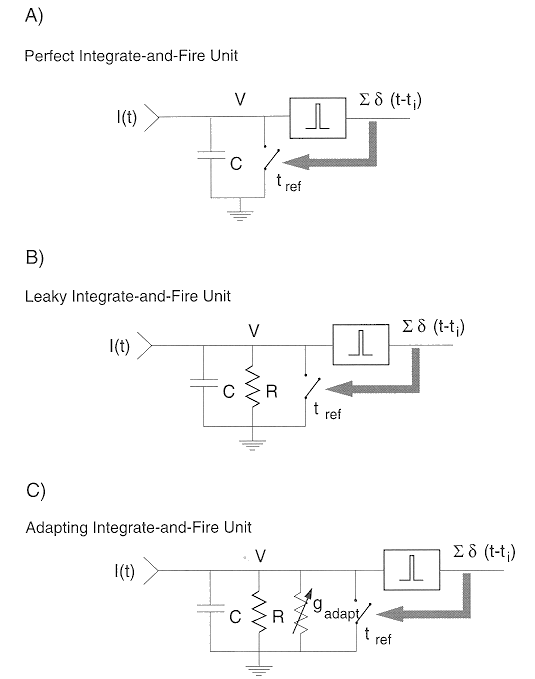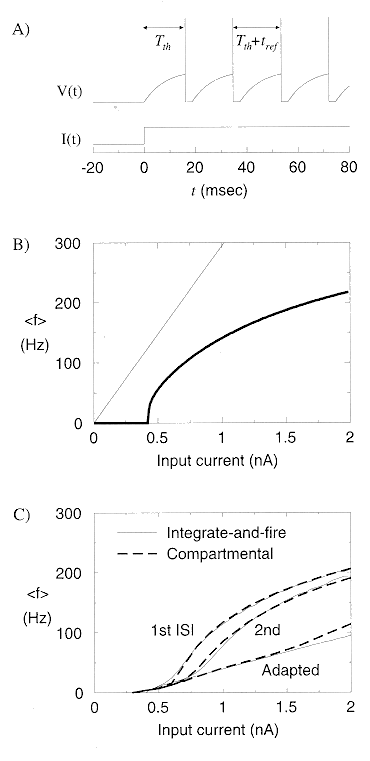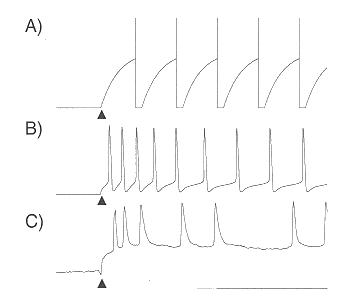


Next: Adapting Model
Up: No Title
Previous: Measuring Neuronal Response -
The generation of a spike train can be modeled by a integrate-and-fire circuit
(also called voltage-threshold model) as shown in the figure. Note that case B
is more realistic than case A as the resistor R is added to simulate the leakage
through the membrane. The circuit is very similar to the electrical membrane
model which is also charged by external current. The rectangle represents the
spiking mechanism which generates a spike whenever the voltage across the RC
component exceeds a threshold Vth, and at the same time the switch is
momentarily closed to release all charge stored in C, and the next integration
cycle begins and the circuit will be recharged.

The RC circuit in case (B) is described by this first order differential equation
To solve this equation for V(t), we again first assume the general solution
and find its derivative
Substituting them in the original equation, we have
and get
c1=RI(t)
We now further assume
V(t)|t=0=V(0)=V0 (the initial condition, e.g.
V0=Vrest), we have
and find
c0=V0-c1=V0-RI(t)
Having found both c0 and c1, we can finally get the special solution
We see that V(t) can be considered as the combination of two independent processes,
the discharge of C through the leakage of R from initial V0 (the first term) and
the recharge or discharge of C by I(t) (the second term). Whether I(t) will charge
or discharge C depends on its direction, i.e., whether the neuron is excited or
inhibited.
If we assume a constant external current I(t)=I,
then V(t) will asymptotically approach a final value:
and the rate to reach the final value is
For V(t) to reach the threshold Vth to trigger an action potential, we need
i.e., the minimal sustained current is
Ith=Vth/R
Solving the above expression of V(t) (assuming V0=0)
for t, and replacing V(t) by Vth, we find the time to trigger an
action potential as a function of any external current
I(t)>Ith:
With a sustained external current, a spike train will be generated at the
frequency
| f |
= |
 |
|
| |
= |
 |
|
where
trefractory is the refractory period. When
I(t)<Ith, no spike is
triggered. When
I(t)>Ith, this equation relates the stimulus current I(t)and the firing rate f as shown in the f-I plot (
Vth=16mV, C=0.2nF,
 ,
trefractory=3 msec). We see that the firing rate is a
monotonic function of the external current I when I>Ith.
,
trefractory=3 msec). We see that the firing rate is a
monotonic function of the external current I when I>Ith.

To summarize, we see that higher firing rate f may be caused by
- low threshold Vth;
- small refractory period
trefractory;
- large stimulus current I;
- large R (for high final voltage value);
- small C (for high charge rate dV(t)/dt).
Note here R plays double roles in the charging process. An increased R will
increase  and therefore slow down the growth of
and therefore slow down the growth of
 ,
but this
is not dominant compared to the high final value also caused by increasing R.
In the extreme case where
,
but this
is not dominant compared to the high final value also caused by increasing R.
In the extreme case where
 (the model becomes perfect or
non-leaky), V(t) increases linearly at rate of I/C without bound and reaches
Vth sooner than any
(the model becomes perfect or
non-leaky), V(t) increases linearly at rate of I/C without bound and reaches
Vth sooner than any  ,
as shown here:
,
as shown here:





Next: Adapting Model
Up: No Title
Previous: Measuring Neuronal Response -
Ruye Wang
1999-09-20







